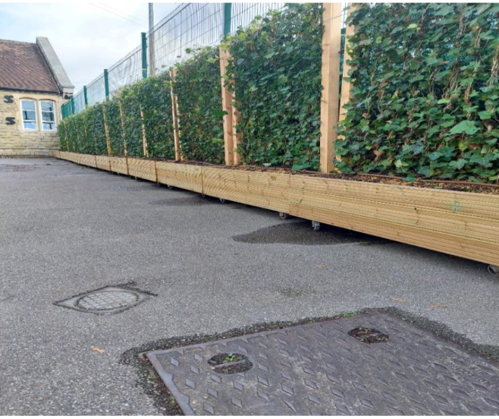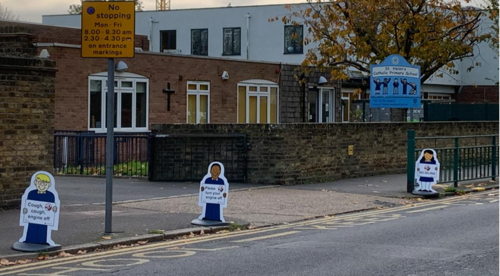Looking for a new role in environmental health?
Whether you're just starting out or ready for your next step, EHN Jobs connects you with the latest opportunities in environmental health across the UK.
Wednesday, 18 June 2025, James Brindle

This Clean Air Day we are shining a light on some of the great work being done by environmental health teams to take action to improve air quality in their communities and to engage the public on this critical area of work.
One project that has been having a positive impact on bringing the issue of air pollution to the attention of the public and making a difference to the local population has been taking place in Southend-on-Sea in Essex.
Southend-on-Sea City Council’s Clean Air for Schools project was an initial two-year project to assess air quality around a number of schools located near roads with high traffic levels, or those within or adjacent to an Air Quality Management Area (AQMA).
Beginning in September 2023, it has proved effective, and Emma Walpole, Regulatory Services Officer – Air Quality at Southend-on-Sea City Council and CIEH member, who led on the project, spoke to CIEH to give members and the wider public an insight on the issues it was looking to tackle and the outcomes so far.
Background and aims of the project
Southend-on-Sea City Council successfully submitted a bid to DEFRA in 2023 for an air quality grant, with funding of £250,000 awarded to help implement the project, while a consultant was also procured to assist with the delivery.
“The project that the team wanted to carry out was to look at the air quality around schools that specifically were on the main roads, so, the A127 and the A13 and also within AQMAs, of which Southend-on-Sea has two,” Emma explained.
“It was the aim of the project to look at the current air quality and see how it could be improved to reduce exposure to the students, the staff and the parents who attend the schools as well.
“Initially schools were selected in those key areas and there were a mix of primary and secondary schools. In the first group, there was seven schools and in the second group there was four schools, so that was 11 in total. We had hoped to include 10 so obviously to get 11 was great.
“We purchased some external air quality monitors that were put up outside each school for initially three months to see what the current levels were at each school, and they looked at Nitrogen dioxides (Nox) and Particulate Matters (PM).
“During that initial monitoring period we also undertook a traffic survey at each school to see kind of the peaks and the flows of the traffic and its impact on the levels that were being recorded.
“We also worked with SAMHE, which was a project with one of the universities who were at the same time as we were delivering our project were deploying indoor air quality devices to schools, so the schools that we were working with were able to register and get those so that we had internal data as well.
“We also undertook assemblies at all the schools to speak to them about air quality and provided learning resources as well. We did a travel survey for the parents and for the staff just to see current behaviours and how people got to the schools – this was all within those initial period of three months of monitoring.
“We then analysed all the data to see what kind of interventions could be put in place and if any were necessary at any of the schools.”


Interventions identified and delivered
That work was carried out over the summer holidays at the schools to reduce disruption and ranged from consideration of window meshes, fitting air purifiers and installing a ‘living green wall’ at one of the schools.
“That school was actually situated in an air quality management area,” Emma continued. “The living green wall was installed either side of a classroom to help reduce particulates in the classroom.
“Following the interventions that were put in place we also undertook an anti-idling campaign. We launched it in September 2024 targeting the schools in the project and the slogan we used was ‘cough, cough, engine off’.
“We had the campaign materials displayed on buses around the city at bus stations, they were placed on some of the parks along the main routes coming in and out of Southend-on-Sea and we also had other digital advertising.
“One of the schools actually did some posters around anti-idling and we put a little video together with some of the children.
“We then did a further three months monitoring at each of the schools and we've just kind of come to the end of that to see if there has been any kind of improvements in the air quality.
“We've also done another traffic survey, repeating it at all of those locations. We’re now at the stage that the consultants that we're working with are putting together those Phase 2 reports based on all the work that's been done.”
Outcomes so far
While the project is still ongoing, Emma said that its impact has been positive, and it has also generated interest outside of those schools that have taken part so far.
“We have definitely found that the visibility of the anti-idling campaign, in particular, has been really well received,” she said.
“We've had contact from councillors who have schools not included in the project so far say they would like banners and materials to use.
“We spoke with DEFRA coming up to the middle of the second round of monitoring and they agreed to extend the project for another year, which meant that we could work with another five schools.
“We have actually been contacted by some schools to say that if we were doing it again that they would be quite eager to join in, which was really good.
“We found that the assemblies that we did with the schools, the children definitely wanted to know more, so we kind of included things that we already do, like our diffusion tube monitoring, where they were located near their schools.
“I know that some of the schools who have ‘eco warriors’ or ‘Planet Earth’ teams within their schools have said they’ve spotted one on their way to school and said that they wouldn't have known about what they were or even noticed before, so it’s definitely helped raise that awareness.
“We hope now in the next refresh of the anti-idling campaign to hopefully work with Southend University Hospital, libraries and health centres just to get that message spread a bit further.”
Positives for the team as well
As an environmental health professional, Emma said she and her team have found the project extremely rewarding and have seen how it has also helped get young people interested in the work they do.
She said: “I worked in Environmental Protection for a number of years, so quite different to air quality, and I moved into air quality just at the start of the project.
“I found it very different to be in the role of providing information in a learning environment like schools, which wouldn't have been something that I would have done before. But it's been really well received, and it's been very interesting to see the work we do from a different side.
“The assemblies for the primary schools were targeted towards a much younger demographic obviously but where we've done them in the secondary schools, the students have definitely shown an interest in what we do which has been really nice to see.
“I don't think they were aware that so many different jobs get carried out at the Council, so that's been really interesting and positive to share that information with them.”
Air quality work across the county
The Southend-on-Sea City Council Clean Air School project has proven to be an effective scheme, and Emma says it has been part of a wider focus on tackling the issue across Essex.
“In Essex we have been working on the overall Essex Air Quality strategy which has been in conjunction with EHOs from all of the Essex councils and I found that through that forum, it's been a really great way to hear of what other work has been done around air quality across the county,” she said.
“And we have included in that strategy the project we have done with schools, the anti-idling campaign and all the work that's been done. Because that went out to public consultation this year, we've definitely noticed that more people are aware of what's happening.
“I've even had contact from EHOs and strategic transport at some of the other Essex authorities asking questions like ‘What kind of sensors are you using?’ ‘What kind of work are you looking at doing next? etc.
“We’ve also started looking at, as Essex as a whole, is there anything that we could do around the sensor network for air quality.
“It would be great if there was DEFRA air quality funding, but I think we're also well aware that we have to look and see if there's any other kind of streams that we can tap into to facilitate that work.”
“Protecting children’s health now and for the future”
Southend-on-Sea City Council’s cabinet member for climate, environment and waste, Councillor Lydia Hyde, has been thrilled at the success of the project.
She said: "The Clean Air for Schools project has been a real success story for Southend-on-Sea. We've seen schools embrace innovative solutions – from installing air purifiers and living green walls to using real-time monitoring to understand and tackle pollution. It’s not just about cleaner air; it’s about protecting children’s health now and for the future.
“Thanks to DEFRA funding and the dedication of our schools and officers, we’re making real progress in reducing harmful emissions and helping students understand the importance of cleaner air.
“This work is a vital part of our wider commitment to create a healthier, more sustainable Southend-on-Sea for everyone who lives, learns or works here."

Looking for a new role in environmental health?
Whether you're just starting out or ready for your next step, EHN Jobs connects you with the latest opportunities in environmental health across the UK.